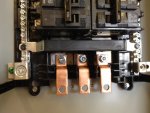I will attempt to answer in the context of the 2011 NEC. I use the 2008 currently in CA, but learning for 2011 adoption. Please flag any errors I make.
I believe the question relates to the where to locate the System Bonding Jumper for the separately derived system (transformer) in accordance with 250.30(A)(1), and if done at the panelboard, how is the Y neutral and grounding conductor isolated from one another.
If the System Bonding Jumper (screw to case) is at the disconnect panelboard, which includes connection to the grounding electrode conductor, then there is an equipment bonding conductor back to the transformer metal enclosure. Because the secondary Y neutral is not bonded to the enclosure at the transformer output, there is no parallel path for load currents from the panelboard to the transformer output.
The neutral wire carries load current and the secoundary equipment bonding jumper protects for ground faults.
In addition, just to make sure I get this right, the equipment bonding conductor from the secoundary panel connects to the transformer case and to the primary equipment bonding to the delta side OC device panel. All sized to 250.66 based on the ungrounded conductor size.
Just to check some math for 75kVA Delta to Y Polyphase (3 phase), 480V to 120/208V:
Assume 75 degree C terminals. No non-linear loads (3rd harmonic).
Primary OCD = 125A, with 2AWG ungrounded conductors.
Secondary OCD = 300A, with 350 kcmil ungrounded conductors.


